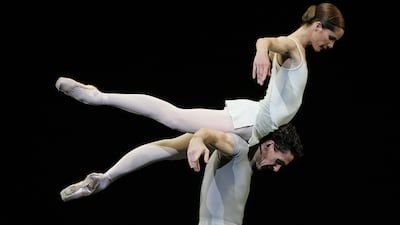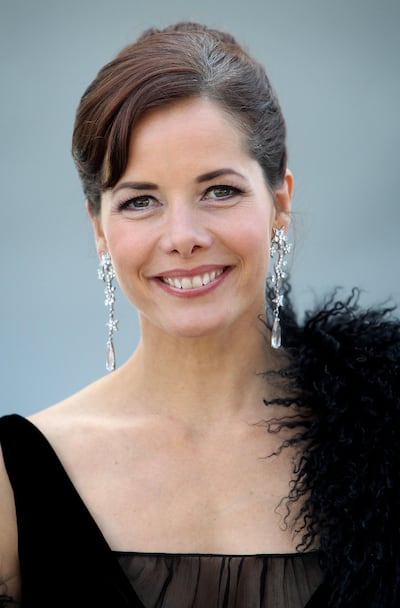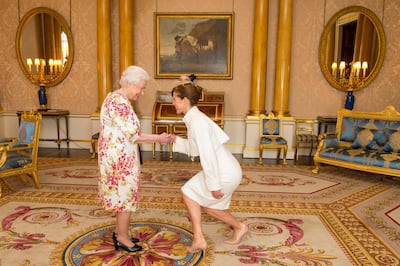Darcey Bussell has much to celebrate this year. She turned 50 a fortnight ago, an occasion she marked with a dinner in her favourite Chinese restaurant in Oxford with 50 friends and family. "I want the celebrations to last for the year," she says. "You have to make a big deal when you get to that age."
It is also exactly three decades since she first stepped on stage as the Royal Ballet's youngest ever principal dancer at the age of 20, a role that propelled her, fresh-faced and fawn-like, into the limelight. Many before her have stumbled under the kind of scrutiny that living a very public life brings. Perhaps spending so much time elevated on impossibly pointed toes helped Bussell keep her balance, but today she has the mannerisms, attitude and determination of a prim, can-do head girl. As the fashion designer Jasper Conran, who first worked with her when she modelled his ballet-inspired 1990 autumn/winter collection, says: "She is still exquisitely beautiful – the result, no doubt, of a blameless life."
When we meet at the Emirates Airlines Festival of Literature in Dubai shortly before her birthday, Bussell is impeccably dressed in a polka-dot pussy bow blouse and slim-fitting black trousers. With perfect posture, she still has the poise and grace that first made her a darling of the ballet and fashion worlds.
Creating opportunities for others
She has served as a muse for everyone from the late choreographer Sir Kenneth MacMillan, who first plucked her from obscurity to star as the heroine in The Prince of the Pagodas in 1989, to photographers such as Lord Antony Snowdon, Mario Testino and Annie Leibovitz. If Bussell is daunted by the idea of getting older, she certainly isn't showing it. "I keep myself quite busy, so I haven't really focused on it. I'm not at all apprehensive about getting old. It's only a number. I'm more conscious of my health and keeping a healthy mind and body."
That’s just as well, because she has worked in not one but three industries – ballet, fashion and modelling – that have a notoriously short shelf life and can be particularly brutal on women. Four years ago, Bussell had hip resurfacing surgery, a procedure typically carried out on patients in their 60s and above, but not unusual for dancers at a much younger age because of the unnatural stress placed on their bodies during their careers.
Bussell, who retired from the Royal Ballet at 38 after nearly two decades as principal, says: “It’s a young person’s profession because it is like being an athlete. It’s up to the body [how far you go]. It is not like the Paris Opera, where they retire you at 40 and that’s it, but it’s also important to let the next talent come through. If you stay there, you never give other people the opportunity.”
On the #MeToo movement
Beyond its physical challenges, ballet is undergoing a moment of self-reckoning in the wake of the #MeToo movement. Peter Martins, the long-standing artistic director at the New York City Ballet, stepped down earlier this year amid allegations of sexual harassment, and physical and verbal abuse. While an inquiry did not find evidence of misconduct, the lawsuit painted a murky picture of “an out-of-control, fraternity-like atmosphere”, in which female dancers were allegedly photographed and filmed nude without their knowledge by other members of the company, according to ballerina Alexandra Waterbury. One male dancer resigned and two others were suspended when the accusations emerged. In a separate incident, Ukrainian-born dancer Sergei Polunin was dropped by the Paris Opera after making allegedly racist and sexist comments on Instagram.
Bussell says she had no personal experiences of the kind. “It was very collegic and a great atmosphere. We were all there for the same goal.” But she adds: “I think this happens all the way through life in any career and has happened ever since ballet existed. There will always be some sort of scandal, whether a person is given too much power or has been directing for a long time. I don’t think it tarnishes the job in any way. The people that are going to drive [this industry] are the artists who love what they do.”
How she found her way
Bussell herself didn't always love the art, despite starting Saturday ballet classes at the age of five. "I came to it quite late. I was not into it at five; I was only doing it because my friends were doing it and I had knock knees, so it was good for strengthening my legs," she says.
Would-be dancers usually join vocational ballet schools at the age of eight. “It is a bit like gymnastics or going to the Olympics; you have got to do the hours at a young age, otherwise you might not have the technique or the body strength. You have to make a lot of sacrifices. My mother did not want me to do ballet because she realised how intense it was, so I went to a stage school first. I did not fall in love with ballet until I was 12 and told her this was what I wanted to do – and thank goodness I did.”
She joined the Royal Ballet School at 13 and, as she says with that prefect's disposition, "thrived in the environment of a regimented and disciplined vocational school". Within four years, she was touring with the Sadler's Wells Royal Ballet, where she was spotted by Sir Kenneth. He cast her in The Prince of the Pagodas, which premiered in December 1989. "I sensed even then that it would probably set the tone for the rest of my career," she says.
Balancing dance with motherhood
Bussell is what The Guardian once described as "flirty and guileless"; part English rose, part head girl, she is transformed on stage with sensual, delicate moves and seemingly impossible contortions that she makes look perfectly effortless. These skills catapulted her to become one of the most beloved – and certainly the most high-profile of her time – British ballerinas, joining an uber-league that included Dame Ninette de Valois and Margot Fonteyn.
So entrenched was Bussell in the British psyche that when she took her final curtain call, sobbing, on stage at the Royal Ballet in June 2007, it made the News at Ten. By then, she was a mother to Phoebe, then six, and Zoe, three. Taking the children on tour with her and returning to dancing five months after giving birth had taken its toll.

“It’s very hard to come back as a mother because it is physically demanding,” she says. “After my second daughter, I was performing in New York five months later, and it was tough to get back to that level of fitness. I wanted the best of both worlds. My mother would come with me, and a lot of the dancers were supportive and helpful, but it is not very compatible because that sort of career involves going on tour and a lot of work in evenings and on weekends.”
There is, she says, more psychological support for dancers now and training to help them transition to a second career. “You have a different goal because you know the career is very short so you have got to make the most of it.”
Life after ballet
But, unexpectedly for Bussell, ballet did yield a second career – and a third and fourth. After a five-year respite in Sydney with her husband, Australian businessman Angus Forbes, and their children, she returned in 2012 as a judge on the hugely popular British TV show Strictly Come Dancing.
The show has become as renowned for unveiling an unexpected side to celebrities and propelling politicians to cult status (think former treasury secretary Ed Balls dancing Gangnam-style or former Tory MP Ann Widdecombe doing the salsa) as it has for launching “the Strictly curse” – with a number of its stars abandoning families and spouses to run away with dancers. While Bussell says it’s a “lovely show to be part of and [see] how people react as they find out things about themselves”, she refuses to be drawn on the so-called curse. But a few weeks after our conversation, she quits the show – reportedly in part because she was fed up of the scandals, according to British tabloids.
Championing for children
Far from taking it easy, she will instead be throwing herself headlong into her other ventures. As well as coaching at the Royal Ballet and taking part in BBC documentaries on the importance of dance to physical and mental health, she launched Diverse Dance Mix (DDMix) just over two years ago, a campaign to persuade state schools in the UK to incorporate dance into PE lessons.
Forty schools are already on board, learning moves from Bollywood and traditional Chinese and Japanese dances – as well as ballet – as part of the curriculum. “I realised what I had known all my life – that dance should be an essential part of education,” she says. “I wanted to make sure every child of every ability had exposure to dance. Children doing this programme change and gain confidence; it empowers them.”
But isn’t ballet still a bit elite? The cost of lessons alone can be prohibitive, particularly for children attending state schools. “I have been working hard to break that down,” she says. “It is often the theatre that ballet is performed in that pushes people away. The more you do dance in other arenas and mediums, the more it brings in audiences.”
She aims to introduce it in every state school in the UK and is embarking on a national tour to promote DDMix this month. She also thinks it can be used to help those at the other end of their lives, such as those suffering from Alzheimer’s or Parkinson’s disease, as well as helping people with depression or anxiety. “It’s not rocket science. Something so simple can be used for balance in life. It is not just going to be technology that makes our lives easier.”
The highlights of Bussell's remarkable career are celebrated in the recently published Evolved, a beautiful and lavish coffee-table book cataloguing her path from a teenager, wide-eyed and tremulous in the company of greats, to her performance as a phoenix in the London 2012 Olympics closing ceremony, descending to extinguish the flaming cauldron.
She was also made a dame last year for her services to dance. Bussell says performing for Queen Elizabeth II in royal galas was one of her high points: “You realise everything that you worked for, all those opportunities, are being recognised. It takes your breath away. You’re there with people from all different art forms and you have been chosen to perform. It’s a great recognition.”
As for what her 50s might bring, she might have perfected the fouetté and grand sissonne, but she is now looking for greater balance in life. “I think I have got to enjoy things more,” she says. “When you’re younger, it’s easier. At this age, you have so many responsibilities that you are not as good at getting balance.” But, she adds: “I just feel very lucky to have got as far as I did. I might have given up as a performer, but dance opened doors and so many opportunities for me.”




